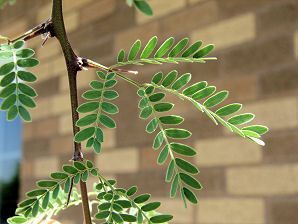Xeriscape Landscaping Plants For The Arizona Desert Environment.
Pictures, Photos, Information, Descriptions,
Images, & Reviews.
Trees.
Palo Brea Trees, Parkinsonia praecox.
We Are Proud Of Our SafeSurf Rating!
Click On Any Of The Following Links By Amazon.Com
For Books, & Videos About Wildflowers Of Arizona & The Southwest USA. No Obligation!
 |
| Palo Brea, Parkinsonia praecox, Photo Taken May 10, 2006 At Peoria, Arizona. |
|---|
 |  |
| Flowers. Palo Brea, Parkinsonia praecox. | Leaves. Palo Brea, Parkinsonia praecox. |
|---|
 /
/

Palo Brea Trees.
We wish to thank Wikipedia, the free encyclopedia for some of the information on this page. We share images and information with Wikipedia. Palo Brea grows to about 25 feet tall and wide, and it has a symmetrical, umbrella- shaped canopy. Its smooth green bark and bright yellow flowers have made this a very popular tree in the Phoenix area. It's leaf growth is lusher than the other Palo Verdes. Palo Brea is more cold sensitive than the other Palo Verdes and it is susceptible to some frost damage on new growth. Palo Brea prefers good drainage. It thrives in areas of lots of sun and heat retention in the winter months. Avoid extensive pruning during the summer months. Supplemental watering during summer.
Quick Notes:
Height: Up to about 20 - 25 feet tall, spread about 20 - 25 feet.
Trunk/Twigs: Up to about one foot in diameter. The branches and most of the main trunk are trunk and branches blue-green.
Thorns: 2 - 3 inch long thorns. Usefull as a barrier tree.
Flowers: Bright yellow with five petals, pistils may be red - brown. 4 - 5 flowers in a cluster less than 2" long; covering the tree in spring, sometimes again in late summer. Yellow flowers in the spring. Upper flower petal often bears orange dots.
Blooming Time: May - June.
Seed Pods: 1 1/2 - 3 1/4 inches long; narrowly oblong, flat, thin pods; short-pointed at ends, yellowish-brown; maturing and falling in summer; 2-8 beanlike seeds. Seeds are dark red - brown.
Seeds: Smooth hard seeds are only slightly flattened with 2 to 7 found in each pod.
Leaves: Leaves are bipinnately compound, in pairs, about 1/2in long with leaflets of 1/4 to 1/8in; often leafless most of the year, normally each fork bearing 1-3 pairs of smooth, tiny leaflets, that are shed in early summer. This is in contrast to Foothills Palo Verde which usually has 4 or more tiny leaflets.
Found: Native to Mexico in Baja California, Baja Sur, Sinaloa, Sonora, Zacatecas, Guerrero, Jalisco, Michoacan, Oaxaca, & Puebla. Native to South America in Venezuela, olivia - Santa Cruz; Ecuador; Peru, Argentina - Catamarca, Chaco, Cordoba, Formosa, Jujuy, La Pampa, La Rioja, Mendoza, Neuquen, Rio Negro, Salta, San Juan, San Luis, Santiago del Estero, Tucuman; & Paraguay.
Elevation: 0 to 4,000 feet. Does best under 3,000 feet.
Hardiness:
Soil pH requirements:
Sun Exposure:
Habitat: Dry, well-drained soils; drought tolerant.
Miscellaneous: Bark remains green, even with age. Beware of hybrids that do not retain green bark or have distinctive growth habit. Flowering Photos Taken May 10, 2006 At Peoria, Arizona.
|



We Are Proud Of Our SafeSurf Rating!
Click On Any Of The Following Links By Amazon.Com
For Books, & Videos About Xerioscape Plants Of Arizona & The Southwest USA. No Obligation!
Back To Arizona Xeriscape Landscaping Main Page.
Back To Xeriscape Trees Page Two.
Back To Arizona Wild Flowers Home Page
Back To DeLange Home Page
© 1966 - Present, Audrey, Eve, & George DeLange
| © 1966 - Present, Audrey, Eve, & George DeLange |


